Guitars, many people play them or collect them, but not many of them know the background of the string instrument of their choice. The name "guitar" comes from the ancient Sanskrit word for "string" - "tar".
To be able to distinguish guitar from other similar string instruments we need to define what guitar actually is:
"A stringed musical instrument with a long, fretted neck, a flat, somewhat violin like body, and typically six strings, which are plucked with the fingers or with a plectrum".
Until this day, no one can exactly date the first string instrument, but professionals date it to approximately 4000 years ago. First string instruments resembled more to a harp or a tanbur (picture 1).
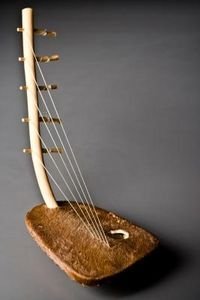
Picture 1
Oldest guitar-like instrument was found in Egypt, around 3500 years ago. It is believed that it belong to an Egyptian musician by the name of Har-Mose (picture 2). It was found in his grave right next to him, so he could play it in the other life. The instrument it self resembles more of a tanbur than a guitar but its the closest thing to a modern guitar to that point in history. Har-Moses instrument had three strings and a plectrum suspended from the neck by a cord. The soundbox was made of polished cedarwood and had a rawhide "soundboard". Today it can be found in Archaeological Museum in Cairo.
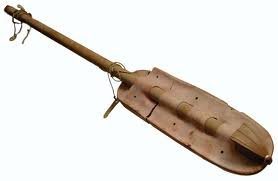
Picture 2 – Har-Moses instrument
Luthiers in the most of the world continued making instruments based on this model, but Europeans gave it a little twist adding frets and angle on the headstock (picture 3). This kind of instrument is commonly called a lute. Lute is by definition:
"short-necked instrument with many strings, a large pear-shaped body with highly vaulted back, and an elaborate, sharply angled peghead".
They figured out that if you put a lot of downforce on the nut, you will get better tone, better tuning and more stability. European luthiers thought of two things when making changes, string vibration and tension. When you bang metal to wood you will get bassy tone, but if you knock metal to metal you will get more defined higher pitch tone. Due to string height and tension you can get similar tones with both. Wood tends to change it shape due to the humidity and temperature, and strings pull the neck closer to the body (to the bridge), and when you combine those two factors you get a bent neck. That is why most multi string instruments had short necks.
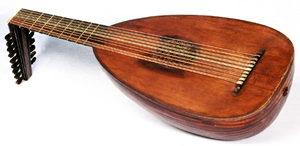
Picture 3 – Lute
As you may know, people did not only trade with money in that time. Most of things people had was acquiered trough trade. So many sailors, merchants and travelers exchanged their instruments for other goods. Years after that, different cultures developed different instruments like: dotar, sitar( picture 3.1), setar, chartar; but the concept has not changed much. There were more esthetic or playability modifications like shape, wight, angles, number of strings, tunings etc.

Picture 3.1 - Sitar
It is considered that today guitars were constructed by the model of four-stringed Persian chartar. It had narrow waist that looks a lot like modern guitars (picture 4). Somehow it got in to hands of Spanish luthiers who changed its construction, and acquired pairs of unison-tuned strings instead of single strings and became known as the quitarra or chitarra.
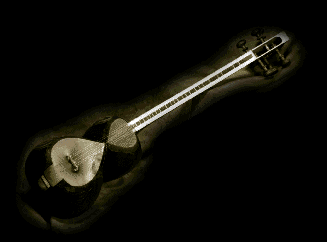
Picture 4 – Persian chartar
Trough the 16-th century many luthiers made their own model or idea how this instrument should work, even the world-famous luthier Antonio Stradivari took a shot at it and made some beautiful instruments (video of Rolf Lislevand playing A.Stradivari Sabionari)
At the beginning of the 19th century one can see the modern guitar beginning to take shape. Bodies were still fairly small and narrow-waisted (picture 5).

Pictrure 5 - 19th century guitar
The modern "classical" guitar took its present form when the Spanish maker Antonio Torres increased the size of the body, altered its proportions, and introduced the revolutionary "fan" top bracing pattern, in around 1850. His design radically improved the volume, tone and projection of the instrument, and very soon became the accepted construction standard. It has remained essentially unchanged, and unchallenged, to this day. (picture 6)
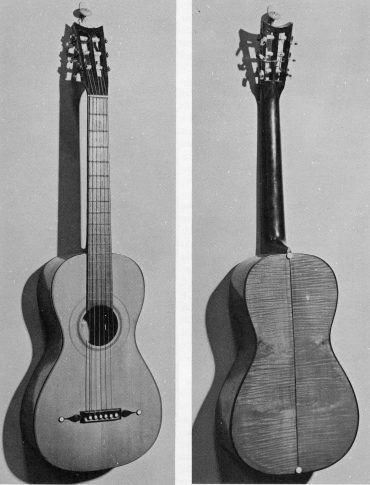
Picture 6 - 6-string guitar by George Louis Panormo, 1832
This is cool ... thank you for this ;)
This is interesting topic. I'd like to see an article about modern day acoustic guitars. There are so many different shape and sizes, not to mention different variations in different continents.
I never had the courage to build one, but maybe in future...